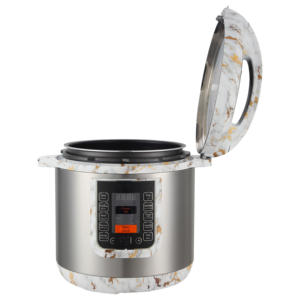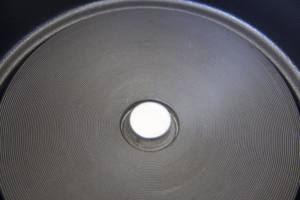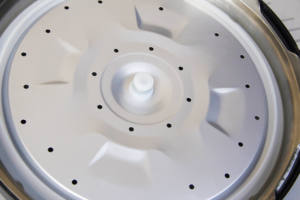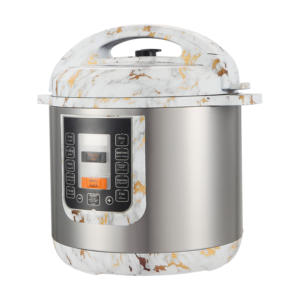
All categories
Featured selections
Trade Assurance
Buyer Central
Help Center
Get the app
Become a supplier

(1123 products available)










































Malaysia pressure cookers are cooking appliances that use steam pressure to cook food fast. There are several types of pressure cookers in Malaysia, each with unique features and benefits.
Stainless steel pressure cooker
This is one of the most popular types of pressure cookers in Malaysia. The body of the cooker is made of stainless steel material, known for its durability and ability to withstand high temperatures and pressure. This type of Malaysia pressure cooker comes with a thick base that ensures even heat distribution, preventing hot spots and cooking food uniformly. The stainless steel material is also non-reactive, making it safe for cooking acidic and alkaline foods. It is easy to clean and maintain, making it a good choice for households.
Aluminum pressure cooker
As the name suggests, this type of pressure cooker is made from aluminum material. It is lightweight and has excellent heat-conducting properties, allowing for fast cooking. Typically, the body of the cooker is made of anodized aluminum, which is more robust and resistant to corrosion than regular aluminum. Malaysia aluminum pressure cookers are also affordable and have good wear and tear resistance, making them ideal for everyday use.
Electric pressure cooker
Electric pressure cookers in Malaysia are becoming more popular due to their convenience and user-friendly features. Unlike traditional stovetop cookers, the electric version has an in-built heating element that generates the required pressure and heat for cooking. This type of cooker has digital controls and preset cooking functions that allow users to cook different dishes with just one button, ranging from pressure cooking, slow cooking, steaming, sautéing, and more. It also comes with safety features such as automatic pressure release and lid locking mechanisms to prevent accidents. Electric pressure cookers are suitable for those who want to save time and energy in the kitchen.
Combo cookers
These Malaysia pressure cookers are designed to perform multiple cooking functions. They can work as both pressure and non-pressure cooking appliances. With their versatile cooking options, users can prepare a wide range of dishes using different methods. Combo cookers are usually equipped with removable inner pots that allow for easy transfer of food from the stovetop to the serving table. They are ideal for those who want an all-in-one cooking solution that takes up less space in the kitchen.
Exterior
Most pressure cookers have a shiny, metallic exterior. This exterior is usually made of stainless steel or aluminum. The stainless steel exterior is usually multi-clad, meaning multiple layers of different metals are used. This helps with heat retention and distribution. On the other hand, the aluminum exterior is usually lightweight and budget-friendly. In addition to this, the exterior of the pressure cooker has handles and knobs.
Interior
The interior of the pressure cooker consists of a pot in which food is placed. This pot is made from materials such as stainless steel, aluminum, or non-stick materials. All of these materials vary in their properties. For instance, pressure cookers with aluminum pots are lightweight and heat up quickly, whereas pressure cookers with stainless steel pots are more durable and rust-free. On top of all this, the interior also has a lid that must be locked to create pressure.
Design and Safety Features
Most pressure cookers have a design that includes multiple safety features. For instance, they have a pressure release valve that helps release pressure when the lid is locked. This is important for maintaining pressure levels. Additionally, some pressure cookers are designed with a gasket. This gasket forms an airtight seal between the lid and pot, helping pressure and steam build up. Furthermore, pressure cookers also have a safety lock that prevents opening when the pot is pressurized and hot.
Cooking spicy dishes in a hurry:
Malaysian curries, rendang, and sambal are famous for their spicy and flavorful dishes. A pressure cooker is suitable for cooking these spicy dishes quickly. The pressure cooker cooks the spices and ingredients under high pressure, producing a flavorful dish within a short time.
Stewing tough cuts of meat:
In many traditional Malaysian dishes, tough cuts of meat (like beef shank or lamb leg) are used. Pressure cookers tenderize these tough meats quickly, making them soft and delicious. It is also great for cooking dishes like oxtail soup or meat stews that need beans or vegetables.
Preparing traditional rice dishes:
Pressure cookers can also help cook popular Malaysian rice dishes like nasi lemak or biryani rice. These rice dishes usually involve long cooking times to allow the spices to infuse into the rice fully. Using a pressure cooker reduces cooking time yet still produces fragrant, delicious rice.
Canning and preserving:
With the increasing popularity of home gardening and organic produce, pressure cookers are also used for canning and preserving. They can create a sealed environment to preserve jams, sauces, or pickled vegetables while maintaining freshness and taste.
Cooking beans and legumes:
Many Malaysian dishes contain beans and legumes, such as lentils in dalh or chickpeas in roti jala. These beans usually require a long cooking time to become soft. Using a pressure cooker cooks them faster, allowing users to prepare their favorite dishes more conveniently.
Cooking soups and broths:
Delicious soups and broths are the foundation of many Malaysian dishes. Pressure cookers can extract flavors from bones, meat, and herbs in a short time, producing a rich and aromatic soup. Whether cooking bak kut teh (pork rib tea) or herbal chicken soup, using a pressure cooker can save time while still producing a flavorful soup.
Cooking in a limited time:
For those who work or study but still want to enjoy home-cooked meals, pressure cookers become lifesavers. When returning home late but craving traditional Malaysian dishes, pressure cookers can quickly prepare curries, soups, or stews, providing convenient solutions for busy individuals.
Safety Standards:
Look for pressure cookers that meet recognized safety standards. In Malaysia, in addition to the local standard, the Malaysian SNI (Standards Malaysia National Standards) certification is preferred. Internationally, it should have certifications such as the American National Standards Institute (ANSI) and the Canadian Standards Association (CSA).
Material Quality:
Choose pressure cookers with high-quality materials. The body should use stainless steel with good corrosion resistance. It is durable and safe for cooking. The seal ring and safety valve should use food-grade silicone or high-strength plastics to ensure safety and durability.
Manufacturer Reputation:
Choose pressure cookers produced by well-known manufacturers. These manufacturers have a reputation to protect and typically invest more in product safety and quality. They provide clearer user manuals and warnings to ensure users use the product safely.
Product Features:
Choose pressure cookers with multiple safety devices, such as pressure release valves, safety locks, and excess pressure indicators. These features can prevent accidental high pressure and ensure the product's safe working.
Usage Guidelines:
Read the product manual and safety warnings before using the pressure cooker. Follow the manufacturer's usage guidelines to ensure safe operation. For example, do not exceed the maximum fill line, and always use the pressure release method as instructed.
Warranty and Support:
Check the warranty period and after-sales support for the pressure cooker. A good warranty and support can ensure that you can obtain product safety information and resolve safety concerns in a timely manner.
Q1: What are the benefits of using a Malaysian pressure cooker?
A1: Malaysian pressure cookers are made to last, cook food quickly while retaining flavor and nutrients, and be energy-efficient.
Q2: How can one use a Malaysia pressure cooker?
A2: Fill the pot with the desired ingredients and liquid, ensuring it does not exceed the maximum fill line. Close and lock the lid, then place it on a suitable heat source, reducing it to the necessary cooking pressure.
Q3: What types of foods can be cooked using a Malaysian pressure cooker?
A3: Pressure cookers are versatile and can cook curries, stews, soups, rice, beans, meats, vegetables, and even desserts like puddings and cakes.
Q4: Are Malaysia pressure cookers safe?
A4: Safety is prioritized in the design of pressure cookers, which are equipped with multiple safety features such as pressure release valves, locking mechanisms, and handles that prevent accidents.
Q5: How can one clean and maintain a pressure cooker from Malaysia?
A5: After it has cooled down completely, clean the pot and lid with warm soapy water, paying particular attention to the sealing ring and valves. To maintain it, periodically oil the locking mechanism and check for any worn-out parts.